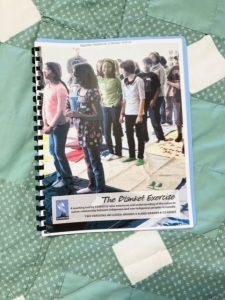19
Amanda R. Dumoulin
Contributor’s Biography:
Amanda R. Dumoulin is a 3rd year student at Kwantlen Polytechnic University studying Education.
Resource Overview
Weblink PDF:
KAIROS. (2012). The blanket exercise. https://teacherlauragroome.files.wordpress.com/2015/05/kairos_blanketexercise_afn_version-revised_aug2012_lowresolution.pdf
Grade Level: Grades 4-12
Description:
The KAIROS Blanket Exercise is an interactive guided workshop that examines the relationship between Indigenous and non-Indigenous Peoples in Canada, from history to present times. The Blanket Exercise provides two different formats. One format is shorter, uses more straightforward language, and aims to educate children in grades four to eight. The other format is more descriptive and complex, geared towards participants in grades nine to twelve, also applicable for adults. To implement this resource, the facilitator briefly discusses Canada’s history and the subjugation of Indigenous Peoples in North America. The KAIROS Blanket Exercise ranges from 1-3 hours. It incorporates an interactive demonstration which takes approximately one hour, while the discussion and reflection component takes the final 1-2 hours. The activity portion is a role-playing exercise. The facilitator separates participants into two roles: Indigenous Peoples and European settlers. A participant narrates the activity and a script is provided to help participants empathize with Indigenous Peoples by portraying the realities of colonization. The activity is supported by giving participants tangible objects, the blankets, representing the effects of colonization from an Indigenous perspective.
Significant Indigenous Knowledge:
Necessary Prior Knowledge:
Suggested Learning Activities
A possible activity is the enactment of the KAIROS Blanket Exercise. The facilitator will provide many of the tools necessary for the activity: 10 or more blankets, scrolls, index cards, three maps “Turtle Island,” “Treaties,” and “Aboriginal Lands Today,” which are all provided in the resource link (KAIROS, 2012). Participants are assigned roles: a narrator, Europeans, and Indigenous Peoples of North America. Blankets, which represent Turtle Island, are laid out on the floor. Participants portraying Indigenous Peoples are then instructed to stand on the blankets, that represent their land. Throughout the activity, the narrator reads through a script, calling on participants to read from scrolls and perform actions. The re-enactment demonstrates the historical interactions between Europeans and Indigenous Peoples. It provides a timeline that shows the systematic and oppressive treatment of Indigenous Peoples. Participants are offered a new perspective on why it is vital to understand Indigenous histories and the effects of colonization as they have a physical representation of Indigenous land theft.
After the hour-long re-enactment, another possible activity includes a debrief through an independent reflection, as well as a group discussion. A project may be assigned to demonstrate the knowledge acquired through the KAIROS Blanket Exercise and encourage further research on Indigenous voices. The assigned task will be a flexible format to attune to the participant’s strengths and interests. For example, the participant could write an essay, create a presentation, or lead an informal group discussion on content provided in the activity. The group discussion can discuss and unpack the themes and issues represented within the KAIROS Blanket Exercise.
The participants will sit in a circle, providing the opportunity to reflect upon their experiences and share their thoughts and feelings with the group. KAIROS encourages using a feather or stone to indicate the speaker and ensure that one participant speaks at a time. Some potential questions may include “What have you learned today? What was the most emotional moment for you? Was there something you didn’t understand?” (KAIROS, 2012, p. 14).

Image by: Rachel Chong BY-NC-ND (Attribution Non-Commercial No Derivatives)
References
KAIROS. (2012). The blanket exercise. https://teacherlauragroome.files.wordpress.com/2015/05/kairos_blanketexercise_afn_version-revised_aug2012_lowresolution.pdf
KAIROS blanket exercise community. (2020). Home. https://www.kairosblanketexercise.org/
Wilson, K. (2018). Pulling Together: Foundations guide. BCcampus. https://opentextbc.ca/indigenizationfoundations/chapter/43/

